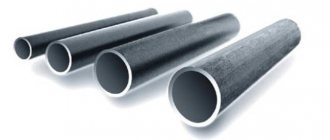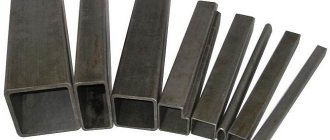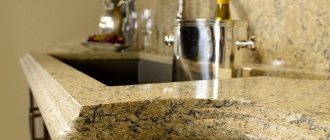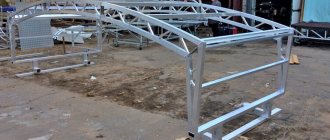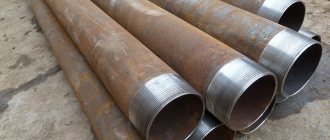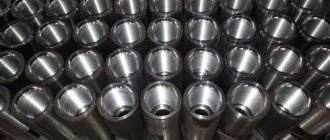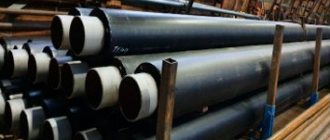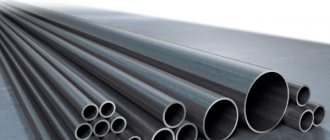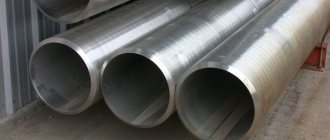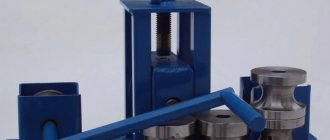Pipes that have a special cross-sectional shape are called profiled. This type of pipe can have not only square and rectangular shapes, but also oval, polygonal, semi-oval and flat-oval. The most popular types of profile pipes are square and rectangular pipes.
Today, such areas as construction, heavy industry, automobile production, furniture production and many others cannot do without the use of profile pipes.
Basically, profile pipes are used to build various kinds of frames, metal structures, and complex floors. In other words, for any structures bearing serious mechanical and vibration loads.
Advantages over round pipes and shapes
Profiled pipes are easily connected to each other by welding. The square cross-section adheres tightly to flat surfaces, and the four ribs provide strength and durability to the structures. As part of building frames, they easily cope with lateral loads, giving buildings stability. Due to the stiffening ribs, with equal weight, their resistance to bending loads is approximately 30% higher than that of round ones. In practice, the use of corrugated pipes can be more economical than channels or beams. In addition, they are easier to store than round ones - they stack compactly.
Profile types
The section of profile pipes can be anything other than round, but there are main types of pipe profiles manufactured by all pipe manufacturers:
- Rectangular. The section has the shape of a rectangle with unequal width and height parameters. The large number of aspect ratio variations makes such professional pipes the most common and widely used.
- Square. The cross-section is rectangular with equal sides. The size range is slightly narrower than that of rectangular pipes, but the breadth of application is the same, since square pipes are simpler to calculate than others.
- Oval and flat oval. The cross-section of the first has the shape of an oval, the second - a rectangle with strongly rounded corners or an oval with straightened long sides. The most difficult to produce and expensive of the standard profiles, as well as the most difficult to calculate and install. However, oval and flat-oval pipes are indispensable for the manufacture of furniture and decor, as they expand design possibilities.
We recommend that you read: Types and applications of galvanized profile pipes
Note! Standard types of professional pipes can be purchased ready-made from most pipe manufacturers. However, manufacturers can perform custom profiling and produce pipes with a triangular, polygonal or complex profile.
Any type of profile can be thin-walled or thick-walled. If the wall thickness is less than 1/20 of the section diagonal, such a pipe is considered thin-walled. For example, a square corrugated pipe with a width of 100 mm has a diagonal of 141 mm. This means that with a wall thickness of 2-6 mm such a pipe will be thin-walled, and with 7 mm or more it will be thick-walled.
Aluminum profile pipe
Aluminum is a light metal, it is three times lighter than steel. Therefore, it is highly valued in the production of metal components, especially in transportation-related industries. This is why profiled aluminum tube is widely used in the automotive and aerospace industries. Fences, gates, fences, handrails, and bicycle racks are made from it. It is sometimes chosen for large structures, such as house construction, due to the moderate strength and low weight of the material. However, in areas with extreme temperatures, aluminum is at risk of deterioration because it has less corrosion resistance than steel.
Profile aluminum tubes are characterized by:
- Light weight.
- The price is lower than that of steel.
- Ease of welding.
- Easy to process (easy to cut).
How are they produced?
Pipe production occurs using electric welding, which is why the quality and strength of the manufactured pipe depends on the quality of the seams. Thanks to modern technologies, the production of high-quality materials is a well-established mechanism. A high-quality seam at the welding site allows the use of profile pipes in interior design, as well as the creation of structures for decorative purposes.
Processing of profile pipes during production can be of two types: cold-forming or hot-forming. In the case of hot forming, the pipe is heated and then cooled. Such pipes have less internal stress, which allows the material to better retain its shape during use.
Steel profile pipe
Alloys of iron and carbon have many valuable properties. This material is three times heavier than aluminum, so it is used in structures that are heavy and/or require resistance to corrosion and extreme temperatures. They are used to build houses and large structures: bridges, roads, oil and gas plants. They are easy to weld, cut, shape and machine as they are a very dense material.
Profile steel pipes are characterized by:
- Heavy weight.
- Strength is higher than that of aluminum.
- Rust resistant.
- Ease of welding.
- Good workability.
Dimensions and shapes of manufactured professional pipes
Today, industrial plants produce professional pipes of various cross-sectional sizes.
The main value of a profile pipe is its high resistance to bending. It is this quality that determines the use of professional pipes. During construction, standard sizes of profile pipes are used for the construction of certain types of structures.
Today, the metallurgical industry produces a huge number of profiled pipes, which can have a wide variety of sizes.
The minimum cross-sectional size that a manufactured product can have is 10x10 mm, and the maximum cross-section can be 450x350 mm. The length of the product produced by industry ranges from 6-12 meters.
The range of manufactured profile pipes is very diverse. The products produced differ both in cross-sectional size and in its shape.
The range of manufactured professional pipes is regulated by GOSTs specially developed for this purpose. The GOST profile pipe has the following 13663-86, in accordance with the requirements of which most of the products are manufactured; in addition, the production of corrugated pipes is carried out in accordance with GOST 8645-68. Each enterprise engaged in the manufacture of this type of product provides potential customers with a full price list for the products, which allows them to familiarize themselves not only with the cost, but also with a complete list of products produced by a particular enterprise in the metallurgical industry.
Stainless steel profile pipes
Stainless steel pipe products are resistant to corrosion and bending loads. The impeccable appearance of the products allows them to be used in various visible places for internal and external landscaping. They are hygienic, therefore they are widely used in structures used in the food industry. Stainless steel profiles can be left uncoated and left in their original form. Rolled stainless steel square pipe is especially popular.
Compared to similar pipe products, stainless steel has a number of advantages:
- Corrosion resistance.
- Aesthetic appearance.
- Good weldability.
- Small mass.
Application of corrugated pipes in construction
Steel pipes of square and rectangular cross-section are widely used in individual construction. The popularity of such elements is explained by the large size range, relatively low weight and high structural strength obtained in the manufacture of frames. Products made from profile pipes have an affordable price and provide less labor intensity. They are much easier to weld and bend than T-bars, beams and other types of metal profiles.
The list of the most popular buildings that can be made from a profile pipe with your own hands includes:
- garages;
- awnings;
- gazebos;
- balconies;
- greenhouses;
- gates;
- gates;
- fences and so on.
Production of profile pipes
For the production of corrugated pipes, materials of various chemical compositions can be used. Profiled pipes are created by rolling (cold or hot forming), as well as using welding and rolling. Therefore, they can be either welded (with a seam) or seamless. When making a welded pipe, a flat steel sheet is taken, which is gradually bent in a circle. After welding the edges, forming is carried out in which the walls are flattened to obtain a square or rectangular shape.
Seamless pipes do not withstand local loads well and are therefore not suitable for the construction of large buildings. For this purpose, it is more expedient to use welded or cold-formed ones.
Section of professional metal pipes
According to the type of section they produce:
- rectangular profile pipe - current GOST 8645-68;
- square pipe - GOST 8639-82.
Square and rectangular steel pipes can have a radius bend with a radius according to GOST drawings or are made with walls forming a right angle.
The angle of the junction of the walls forms a stiffener. Therefore, the strength and resistance of the material to deformation from lateral loads depends on the type of execution.
Products with a radius stiffener are more durable. This is explained by a more uniform distribution of acting loads at the bending point. A frame made from such a profile pipe will have increased load-bearing capacity. Therefore, the demand for this type of rolled metal in construction is higher.
Unlike round pipes, steel corrugated pipes of rectangular and square sections are characterized by more convenient use due to flat walls. They also provide easy transportation and compact storage arrangements.
Cutting profile pipes
Factories produce large products that are then machined for final use. The type of cutting is determined depending on the material and use to which the pipe will be subjected.
Structural pipes for construction or signage are usually cut using more cost-effective mechanical methods that do not require precision cutting. These include a hacksaw and a grinder. At the same time, industrial pipes for cars or furniture often require higher precision and thermal types of cutting, which is why gas-flame and laser systems are used.
Metal-plastic
Advantages and disadvantages
These pipes are cheap and beautiful, easy to assemble into a water supply system and do not require special tools for this. However, due to both the characteristics of the material and installation, they often leak after several seasons.
Standards and sizes
The range of pipes made of metal-polymers is not regulated by GOST R 53630-2009 “Multilayer pressure pipes for water supply and heating systems”; GOST specifies only pipe quality standards.
The actual range of pipe products made of metal-plastic sold in Russia comes down to six standard sizes: 16, 20, 26, 32, 40 and 50 mm.
Criterias of choice
The determining factors when choosing a suitable profile are: shape, section size, wall thickness and the material from which it is made. For the construction of load-bearing structures, preference is given to seamless square or rectangular corrugated pipes made of stainless alloy steel. Wall thickness and large size increase the strength of the profile. They must correspond to the design loads. If standard indicators are not met, the risk of deformation and even destruction of tubular products increases.
How to build a garage from corrugated pipe
For the construction of a garage, an electric-welded professional pipe is used. It has increased load-bearing capacity, which is important to ensure the reliability of the structure. The construction of a garage using this type of rolled metal can be described in several stages:
Welding of the supporting elements of the frame from the corrugated pipe is carried out:
- The foundation for the garage is being poured on the selected site. During the process of pouring the concrete solution, prepared frame racks are installed in the designated locations.
- After the foundation concrete has hardened, the remaining frame structure is welded.
- The subfloor is being poured.
- The garage walls are sheathed using corrugated wall sheets.
Transportation method from the metal depot to the required site
Rolled metal is usually produced up to 12 meters in length. Therefore, very often suppliers experience some difficulties when transporting this material.
For example, to transport a product 8-12 meters long, you need to use special cargo transport, which will cost a pretty penny.
The six-meter profile is the most common option. Delivery of such a structure must be done using a Gazelle, when one end is laid on a horizontal crossbar, and the other diagonally into the body. Using a Gazelle is much cheaper than transporting it by road.
You can always order the material to be cut, a six-meter profile will then turn out to be three meters, and in this case it will fit on the roof of any passenger car.
Welding square pipes
An alternative technology for manufacturing square steel pipes is electric welding. Production involves bending sheet metal into a profile and welding joints. The material obtained in this way is the lightest and has the smallest wall thickness.
The production process looks like this:
- First of all, sheet blanks (strips) are made, for which a suitable strip is cut from a metal roll, the width of which coincides with the cross-section of the pipe;
- The finished strip is fed into the rollers of the machine, due to which a rough semi-finished product is created, which has a square cross-section and a prepared joining seam;
- Next, the workpiece is welded, and this process can be performed in several ways;
- The last stage of welding is calibrating the profile and checking the seam for leaks.
It’s worth saying a few words about welding, which can be done in two ways:
- Induction welding. This method is used to connect pipes whose cross-section does not exceed 20 mm.
- Arc welding. This technique is suitable for pipes that have large dimensions and a wall thickness of about 2-3 mm.
Polypropylene
Advantages and disadvantages
This is perhaps the most popular material for internal water pipes now. At temperatures below 95 C, it perfectly performs its functions: the connections are not inferior in strength to a monolithic pipe, are easy to install, and polypropylene itself is not susceptible to corrosion and is non-electrically conductive.
The only disadvantage we can write down is the inseparability of welded joints.
Connection method: welding
Standards and sizes
The range of round pipes made of polypropylene in accordance with GOST 52134 can have a diameter of 10 mm and up to 1600 with walls thickness from 2 to 61 millimeters.
However, it should be borne in mind that this standard is not only for polypropylene: we are talking about all thermoplastic pipes.
A more realistic idea of the modern market is given by the pipe assortment on the website of one of the leading manufacturers of polypropylene pipes and fittings - Valtec.
There you can see:
- Pipes made of unreinforced polypropylene;
- Pipes made of polypropylene reinforced with aluminum, designed for pressures up to 25 bar;
- Glass fiber reinforced pipes with a working pressure of 20 bar;
- Glass fiber reinforced pipes with a working pressure of 25 bar.
The range of pipe diameters is from 16 to 90 millimeters.
